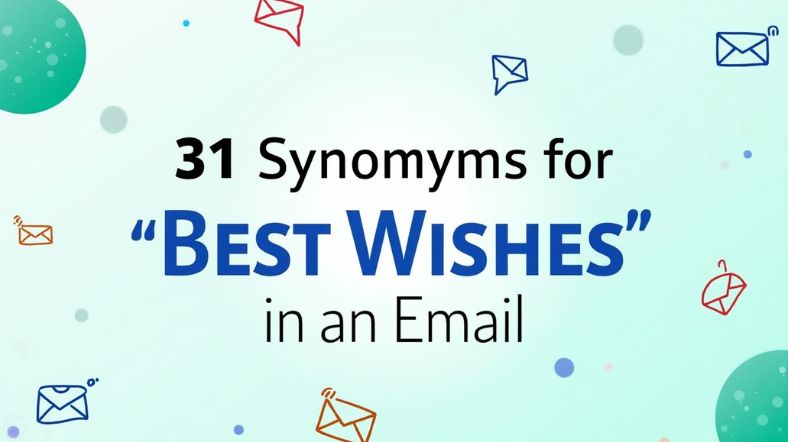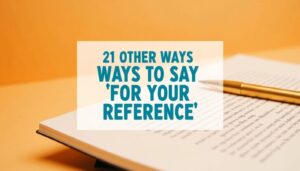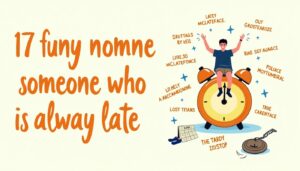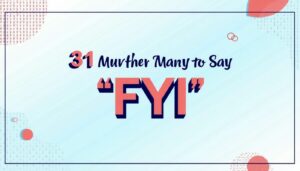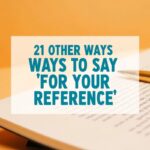Sending a thoughtful closing message in an email is a simple yet powerful way to leave a positive impression on the recipient.
Whether you’re expressing congratulations, encouragement, or simply offering good thoughts, there are many ways to say “Best Wishes.”
In this article, we’ll explore 31 alternative phrases to help you vary your tone, depending on whether you’re writing a formal business email or a more casual message to a friend.
Let’s dive into these options and discover when and how to use them effectively.
Formal Well Wishes
“Formal well wishes” is a phrase that conveys professionalism while still showing your kindness and thoughtfulness. It’s appropriate in corporate settings or when you’re addressing someone you don’t know well, such as a client or business partner.
- Example: “Please accept my formal well wishes as you embark on this exciting new project.”
- Context: This phrase suits business-related emails where you want to maintain a professional tone but still express positive sentiments.
Casual Best Regards
“Best Regards” is one of the most commonly used email sign-offs. It’s friendly and approachable, yet not too informal. This is a perfect choice when you’re corresponding with colleagues or friends in a more casual context.
- Example: “Looking forward to our next meeting. Best Regards, Sarah.”
- Context: It works well in both work and personal emails, creating a tone that’s warm but professional.
Professional Good Luck
“Good luck” is an encouraging phrase that shows your support for someone’s endeavors, whether it’s a job interview, a new project, or a life event.
- Example: “Wishing you professional good luck as you take on this new challenge.”
- Context: Use this phrase in emails where you’re offering support, such as congratulating a colleague on a new role or project.
Informal Warm Regards
“Warm regards” carries a personal touch, ideal for less formal emails. It’s often used among colleagues with whom you have a friendly relationship, or with people you know outside of work.
- Example: “I hope everything goes smoothly with your presentation! Warm regards, John.”
- Context: Best suited for casual emails to people you’re comfortable with, like peers or friends.
Respectful Kind Regards
“Kind regards” is a courteous and respectful way to end an email. It’s a great choice when you want to remain polite but not overly formal.
- Example: “Kind regards, and I hope you have a wonderful weekend ahead.”
- Context: Ideal for business communications or situations where you want to convey respect without too much distance.
Sincere Regards
“Sincere regards” conveys a sense of authenticity and genuine emotion. It works well when you want to express heartfelt thoughts while maintaining professionalism.
- Example: “Sincere regards and best of luck with your new role.”
- Context: This is a great option for emails that require a balance between warmth and professionalism, such as expressing congratulations or support.
Cordial Wishes
“Cordial wishes” is another formal and professional alternative, emphasizing politeness and good intentions.
- Example: “Please accept my cordial wishes for continued success in your endeavors.”
- Context: Perfect for formal business situations or when you need to show politeness to someone you don’t know well.
Genuine Regards
“Genuine regards” conveys a feeling of honesty and warmth. It’s a personal touch in a professional setting, making it suitable for situations that involve genuine appreciation.
- Example: “Wishing you all the best in your new adventure. Genuine regards, Emily.”
- Context: Appropriate for business emails or personal messages when you want to express authentic, heartfelt wishes.
Heartfelt Good Wishes
“Heartfelt good wishes” is an emotionally driven phrase that expresses your sincere, deep encouragement and positive thoughts. It’s perfect for significant life changes, like a promotion or new beginnings.
- Example: “Sending you my heartfelt good wishes as you embark on this exciting new chapter.”
- Context: Ideal for major life events or when you want to offer more than just a formal sign-off.
Polite Regards
“Polite regards” is formal and courteous, showing respect without too much familiarity. It’s a great option for professional emails when you want to stay polite and neutral.
- Example: “Polite regards, and I hope everything works out with your presentation.”
- Context: Suitable for formal business correspondence, such as responding to inquiries or closing emails with clients or superiors.
Authentic Best Regards
“Authentic best regards” adds a layer of sincerity to the usual “Best regards.” It’s a slightly more personal touch while remaining professional.
- Example: “Authentic best regards as you move forward in your career.”
- Context: Perfect when you want to convey true goodwill in business emails or professional communications.
Thoughtful Wishes
“Thoughtful wishes” conveys that you are considering the recipient’s situation with care. This phrase is ideal when you’re sending your support or congratulations for a personal or professional achievement.
- Example: “I’m sending you thoughtful wishes as you begin your new project.”
- Context: Use this in emails where you want to show that you’re paying attention to the recipient’s goals and expressing genuine encouragement.
Warmest Regards
“Warmest regards” is one of the friendliest sign-offs, offering a sense of closeness and personal connection. It’s ideal for semi-formal or casual settings.
- Example: “Warmest regards, and I hope you enjoy your well-deserved break.”
- Context: Great for emails to colleagues, friends, or anyone with whom you share a more relaxed tone.
Honest Good Luck
“Honest good luck” is a direct and heartfelt way to wish someone well. It suggests that your support is sincere and genuine, without pretense.
- Example: “Honest good luck on your presentation tomorrow – I know you’ll do great!”
- Context: Suitable for offering direct and supportive well-wishes in professional or casual contexts.
Friendly Regards
“Friendly regards” strikes a nice balance between professional and personal. It’s perfect for emails to colleagues or acquaintances with whom you have a friendly relationship.
- Example: “Friendly regards, and best of luck on your upcoming project!”
- Context: Best used in casual or semi-formal communication where a tone of warmth and friendliness is appropriate.
Best Wishes Birthday
When wishing someone a happy birthday, the sentiment is joyful and celebratory. You want your message to feel personal and uplifting.
- Example: “Best wishes for a fantastic birthday filled with happiness and love!”
- Context: Ideal for sending to friends, family, or colleagues on their special day. This phrase conveys warmth and good intentions.
Best Wishes for Future Success
If you’re congratulating someone on a new opportunity or wishing them well for an upcoming journey, this phrase shows your support for their future endeavors.
- Example: “Best wishes for future success in your new role – I’m sure you’ll excel!”
- Context: Perfect for congratulating someone on a new job, a promotion, or any big transition.
Best Wishes Quotes
Sometimes, using a thoughtful quote can elevate your message. Combining a well-wishing phrase with a meaningful quote can inspire and motivate the recipient.
- Example: “Best wishes! ‘The future belongs to those who believe in the beauty of their dreams.'”
- Context: A great option for personal emails or messages where you want to inspire someone.
Best Wishes for Friend
When sending best wishes to a friend, your tone can be warm, friendly, and informal. It’s all about showing that you care and are thinking of them.
- Example: “Sending you my best wishes, my friend – I hope your day is as amazing as you are!”
- Context: Best used in casual messages to friends for birthdays, celebrations, or everyday well-wishes.
Best Wishes for Wedding
A wedding is a special occasion, and the best wishes sent on such an event should reflect the happiness and joy of the moment.
- Example: “Best wishes on your wedding day! May your marriage be filled with love, laughter, and endless joy.”
- Context: Ideal for wedding cards or emails to a couple celebrating their big day.
All the Best Wishes for Exam
Exams can be stressful, so offering a supportive and encouraging message can boost someone’s confidence and morale.
- Example: “All the best wishes for your exam! You’ve got this, and I believe in you.”
- Context: A great option for students or anyone preparing for an important test.
Best Wishes Meaning
“Best wishes” itself is a phrase used to express good thoughts or hopes for someone’s future. It conveys positive feelings and is used to wish others well in various situations.
- Example: “Best wishes for all the great things that lie ahead!”
- Context: This phrase can be used in nearly any context to convey goodwill, whether in business or personal communication.
Best Wishes for Future
When someone is about to take on a new journey, whether professionally or personally, sending them your best wishes for the future expresses your hopes for their success.
- Example: “Best wishes for the exciting future that awaits you!”
- Context: Suitable for colleagues or friends who are starting a new chapter in life, such as moving to a new city or starting a new career.
Best Wishes in English
This simple phrase works well in formal or semi-formal contexts. It’s commonly used in professional settings when wishing someone well for the future.
- Example: “Best wishes in all your future endeavors – may you continue to achieve great things!”
- Context: Appropriate for work emails, whether it’s congratulating someone or simply sending them good luck.
Best Wishes Email
When sending an email to wish someone well, a concise and genuine message is key. This phrase works in both professional and personal emails.
- Example: “I’m sending my best wishes for your continued success – have a wonderful week!”
- Context: Perfect for both formal and informal email sign-offs, from congratulatory notes to regular correspondence.
Best Wishes Synonym Email
Finding a synonym for “Best wishes” in an email can add variety and make your message more tailored. Some examples include “kind regards” or “warmest wishes.”
- Example: “Sending you warmest wishes for a speedy recovery!”
- Context: A great alternative when you want to change things up but still express good feelings in an email.
Wish You the Best Synonym
If you want to wish someone the best, there are many alternatives that convey the same supportive meaning, such as “I wish you all the best.”
- Example: “I wish you the best in all your endeavors and hope everything works out beautifully!”
- Context: Perfect for sending your good intentions to anyone embarking on a new journey or goal.
Best Wishes Alternative
An alternative to the usual “Best wishes” could include phrases like “Take care,” “All the best,” or “Good luck.” These alternatives are just as meaningful but offer some variety.
- Example: “Take care and all the best as you move forward with your new project!”
- Context: Great for professional emails or casual messages where you want to change up the phrasing.
Wishing You the Best Synonym
Wishing someone the best in an email doesn’t always have to be formal. You can also say “I’m rooting for you” or “Best of luck.”
- Example: “Wishing you the best – I’m confident you’ll do an amazing job!”
- Context: Use this in both personal and professional emails where encouragement and support are needed.
Best Wishes Message
When crafting a thoughtful message to someone, using “Best wishes” is a classic way to express your heartfelt thoughts. However, alternatives like “My sincere wishes” or “Sending you my warmest wishes” can feel even more personal.
- Example: “Sending you my warmest wishes as you start this new adventure!”
- Context: Perfect for congratulatory messages or any situation where you want to convey heartfelt support.
Conclusion
Using different ways to convey “Best Wishes” can enhance your communication by ensuring it feels sincere and well-tailored to the recipient.
Whether you’re being formal, casual, or somewhere in between, these alternatives help you express your thoughts thoughtfully and professionally.
Experiment with these phrases in your emails to find the ones that best suit your communication style, and you’ll be sure to leave a positive impression every time.

Mark Tony is a grammar expert with 5 years of experience, specializing in teaching English grammar, enhancing writing, reading, and speaking skills for diverse learners.
